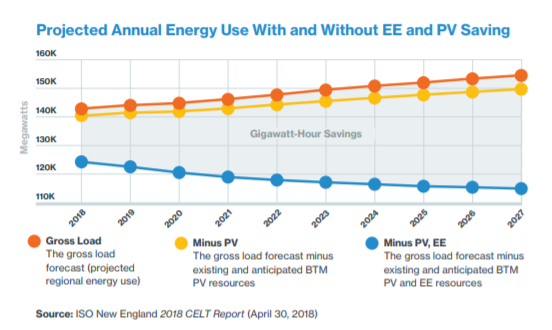 While most New Englanders are busy making summer plans, ISO New England, our regional grid operator, alongside stakeholders, is hard at work ensuring that our grid operates well in winter conditions.
While most New Englanders are busy making summer plans, ISO New England, our regional grid operator, alongside stakeholders, is hard at work ensuring that our grid operates well in winter conditions.
As older, less efficient power generators retire and are primarily replaced by natural gas-fired generators without firm fuel contracts, grid operators warn that the lights could go out. There are solutions to this problem, including investing in winter-peaking clean energy resources such as offshore wind, and shoring up fuel supplies, but one year-round solution is often overlooked: energy efficiency.
Energy efficiency, according to ISO New England’s recently published 2019 Regional Electricity Outlook, has already reduced annual electricity consumption and peak demand significantly since 2005 and will continue to do so over the next decade. Here’s an excerpt from the report:
“Electricity consumers in New England used over 121,000 gigawatthours (GWh) of electricity from the grid in 2018, down from the record 136,355 GWh consumed in 2005. Nearly 3,000 megawatts (MW) of energy-efficiency (EE) measures can reduce electricity demand from New England’s power grid….EE measures are estimated to save an average of 2,059 GWh each year and will reduce peak demand by 281 MW annually.”
The unsung reliability hero of New England: Energy efficiency Click To TweetHere’s a graph from the report, showing the contributions of energy efficiency and solar photovoltaic (PV) and what electricity consumption would be without these resources:
Energy efficiency at work
Energy efficiency shows up, day-in and day-out, delivering seasonally variable but estimable cost and emissions savings to customers, and reducing stress on the grid in all seasons. In fact, improvements such as insulation, lighting and heating upgrades are specifically aligned with reducing electricity demand in dark, winter conditions.
Efficiency saves consumers money while making homes and businesses more comfortable and easier to maintain. A recent EPA report lists the multitude of benefits associated with energy efficiency (and renewables), including improved energy security, stating “Using diverse domestic energy efficiency and renewable energy resources bolsters energy security by reducing the vulnerability of the electricity system when attacks or natural disasters occur.”
In New England – where cold snaps and winter storms are all too common – energy efficiency, combined with a suite of other market actions and state resource procurements, will only serve to ameliorate New England’s winter energy security challenge.
But maintaining, and even increasing, the system benefits of energy efficiency requires commitment and support from grid operators, state policymakers and utilities. In many cases, the notion of not producing electricity feels counterintuitive when faced with the alternative of investing in additional, tangible power stations or fuel supplies. Energy efficiency may be less visible from a grid operator’s perspective, but its impacts have been studied, verified and are directly observable as it reduces our region’s overall electricity load.
Energy efficiency is, and will continue to be, an important resource for the region, providing cost savings and reliability benefits to New England customers. And while New England states have led the nation in energy efficiency investment in recent years, our regional winter energy security challenges should only encourage us double down on this cost-effective reliability solution.
